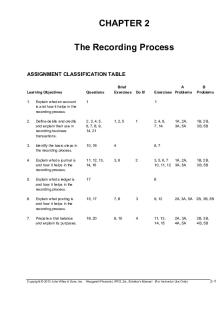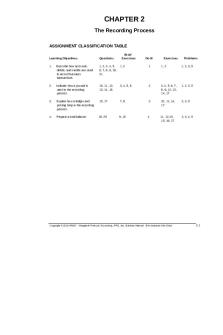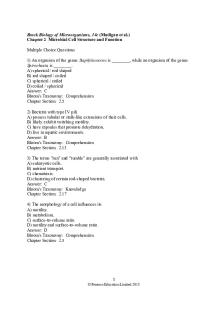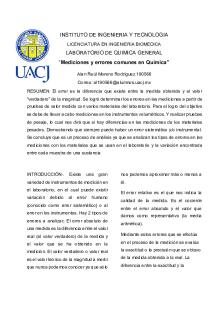CH02 Notes - Professor - Alan He PDF

| Title | CH02 Notes - Professor - Alan He |
|---|---|
| Course | Prin Of Acct I |
| Institution | Georgia State University |
| Pages | 6 |
| File Size | 151.1 KB |
| File Type | |
| Total Downloads | 43 |
| Total Views | 147 |
Summary
Professor - Alan He ...
Description
LEARNING OBJECTIVES REVIEW
1 Identify the sections of a classified balance sheet. In a classified balance sheet, companies classify assets as current assets; long-term investments; property, plant, and equipment; and intangibles. They classify liabilities as either current or long-term. A stockholders' equity section shows common stock and retained earnings.
2Use ratios to evaluate a company's profitability, liquidity, and solvency.
Ratio analysis expresses the relationship among selected items of financial statement data. Profitability ratios, such as earnings per share (EPS), measure aspects of the operating success of a company for a given period of time. Liquidity ratios, such as the current ratio, measure the short-term ability of a company to pay its maturing obligations and to meet unexpected needs for cash. Solvency ratios, such as the debt to assets ratio, measure the ability of a company to survive over a long period. Free cash flow indicates a company's ability to generate net cash provided by operating activities that is sufficient to pay debts, acquire assets, and distribute dividends.
3Discuss financial reporting concepts.
Generally accepted accounting principles are a set of rules and practices recognized as a general guide for financial reporting purposes. The basic objective of financial reporting is to provide information that is useful for decision-making. To be judged useful, information should have the primary characteristics of relevance and faithful representation. In addition, useful information is com parable, consistent, verifiable, timely, and understandable. The monetary unit assumption requires that companies include in the accounting records only transaction data that can be expressed in terms of money. The economic entity assumption states that economic events can be identified with a particular unit of accountability. The periodicity assumption states that the economic life of a business can be divided into artificial time periods and that meaningful accounting reports can be prepared for each period. The going concern assumption states that the company will continue in operation long enough to carry out its existing objectives and commitments. The historical cost principle states that companies should record assets at their cost. The fair value principle indicates that assets and liabilities should be reported at fair value. The full disclosure principle requires that companies disclose circumstances and events that matter to financial statement users. The cost constraint weighs the cost that companies incur to provide a type of information against its benefit to financial statement users. DECISION TOOLS REVIEW
HOW TO EVALUATE RESULTS
DECISION CHECKPOINTS
INFO NEEDED TOOL TO USE FOR FOR DECISION DECISION
How does the company's earnings performance compare with that of previous years?
Net income available to common stockholders and weighted-average common shares outstanding
Can the company meet its near-term obligations?
Current assets and Current ratio=Current current liabilities assets / Current liabilities
Higher ratio suggests favorable liquidity.
Can the company meet its long-term obligations?
Total liabilities and total assets
Debt to assets ratio=Total liabilities / Total assets
Lower value suggests favorable solvency.
How much cash did the company generate to expand operations, pay off debts, or distribute dividends?
Net cash provided by operating activities, cash spent on fixed assets, and cash dividends
Free cash flow=Net cash provided by operating activites−Capital expenditures−Cash dividends
Significant free cash flow indicates greater potential to finance new investments and pay additional dividends.
Earnings per share=Net income−Preferred dividends / Weightedaverage common shares outstanding
A higher measure suggests improved performance, although the number is subject to manipulation. Values should not be compared across companies.
Classified balance sheet - A balance sheet that groups together similar assets and similar liabilities, using a number of standard classifications and sections.
Comparability - Ability to compare the accounting information of different companies because they use the same accounting principles.
Consistency - Use of the same accounting principles and methods from year to year within a company.
Cost constraint - Constraint that weighs the cost that companies will incur to provide the information against the benefit that financial statement users will gain from having the information available.
Current assets - Assets that companies expect to convert to cash or use up within one year or the operating cycle, whichever is longer.
Current liabilities - Obligations that a company expects to pay within the next year or operating cycle, whichever is longer.
Current ratio - A measure of liquidity computed as current assets divided by current liabilities.
Debt to assets ratio - A measure of solvency calculated as total liabilities divided by total assets. It measures the percentage of total financing provided by creditors.
Earnings per share (EPS) - A measure of the net income earned on each share of common stock; computed as net income minus preferred dividends divided by the weighted-average number of common shares outstanding during the year.
Economic entity assumption - An assumption that every economic entity can be separately identified and accounted for.
Fair value principle - Assets and liabilities should be reported at fair value (the price received to sell an asset or settle a liability).
Faithful representation - Information that is complete, neutral, and free from error.
Financial Accounting Standards Board (FASB) - The primary accounting standard-setting body in the United States.
Free cash flow - Net cash provided by operating activities after adjusting for capital expenditures and cash dividends paid.
Full disclosure principle - Accounting principle that dictates that companies disclose circumstances and events that make a difference to financial statement users.
Generally accepted accounting principles (GAAP) - A set of accounting standards that have substantial authoritative support and which guide accounting professionals.
Going concern assumption - The assumption that the company will continue in operation for the foreseeable future.
Historical cost principle - An accounting principle that states that companies should record assets at their cost.
Intangible assets - Assets that do not have physical substance.
International Accounting Standards Board (IASB) - An accounting standard-setting body that issues standards adopted by many countries outside of the United States.
International Financial Reporting Standards (IFRS) - Accounting standards, issued by the IASB, that have been adopted by many countries outside of the United States.
Liquidity - The ability of a company to pay obligations that are expected to become due within the next year or operating cycle.
Liquidity ratios - Measures of the short-term ability of the company to pay its maturing obligations and to meet unexpected needs for cash.
Long-term investments - Generally, (1) investments in stocks and bonds of other corporations that companies hold for more than one year; (2) long-term assets, such as land and buildings, not currently being used in the company's operations; and (3) long-term notes receivable.
Long-term liabilities (long-term debt) - Obligations that a company expects to pay after one year.
Materiality - Whether an item is large enough to likely influence the decision of an investor or creditor.
Monetary unit assumption - An assumption that requires that only those things that can be expressed in money are included in the accounting records.
Operating cycle - The average time required to purchase inventory, sell it on account, and then collect cash from customers—that is, go from cash to cash.
Periodicity assumption - An assumption that the life of a business can be divided into artificial time periods and that useful reports covering those periods can be prepared for the business.
Profitability ratios - Measures of the operating success of a company for a given period of time.
Property, plant, and equipment - Assets with relatively long useful lives that are currently used in operating the business.
Ratio - An expression of the mathematical relationship between one quantity and another.
Ratio analysis - A technique that expresses the relationship among selected items of financial statement data.
Relevance - The quality of information that indicates the information makes a difference in a decision.
Securities and Exchange Commission (SEC) - The agency of the U.S. government that oversees U.S. financial markets and accounting standard-setting bodies.
Solvency - The ability of a company to pay interest as it comes due and to repay the balance of debt due at its maturity.
Solvency ratios - Measures of the ability of the company to survive over a long period of time.
Understandability - Information presented in a clear and concise fashion so that users can interpret it and comprehend its meaning.
Verifiable - The quality of information that occurs when independent observers, using the same methods, obtain similar results.
Working capital - The difference between the amounts of current assets and current liabilities....
Similar Free PDFs

CH02 Notes - Professor - Alan He
- 6 Pages

Lecture Notes Alan Manning
- 151 Pages

Ch02
- 66 Pages

Ch02
- 60 Pages

Ch02
- 18 Pages

11 Gordon Ramsey - he he he
- 7 Pages

HE 211 Midterm 1 Notes
- 3 Pages

He Kaw Teh - He Kaw Teh Anaylsis
- 2 Pages

Ch02 PPT
- 71 Pages

Shell and tube HE
- 46 Pages

Notes - Professor: Erik Thiessen
- 3 Pages

Practica 3 Alan Moreno
- 5 Pages
Popular Institutions
- Tinajero National High School - Annex
- Politeknik Caltex Riau
- Yokohama City University
- SGT University
- University of Al-Qadisiyah
- Divine Word College of Vigan
- Techniek College Rotterdam
- Universidade de Santiago
- Universiti Teknologi MARA Cawangan Johor Kampus Pasir Gudang
- Poltekkes Kemenkes Yogyakarta
- Baguio City National High School
- Colegio san marcos
- preparatoria uno
- Centro de Bachillerato Tecnológico Industrial y de Servicios No. 107
- Dalian Maritime University
- Quang Trung Secondary School
- Colegio Tecnológico en Informática
- Corporación Regional de Educación Superior
- Grupo CEDVA
- Dar Al Uloom University
- Centro de Estudios Preuniversitarios de la Universidad Nacional de Ingeniería
- 上智大学
- Aakash International School, Nuna Majara
- San Felipe Neri Catholic School
- Kang Chiao International School - New Taipei City
- Misamis Occidental National High School
- Institución Educativa Escuela Normal Juan Ladrilleros
- Kolehiyo ng Pantukan
- Batanes State College
- Instituto Continental
- Sekolah Menengah Kejuruan Kesehatan Kaltara (Tarakan)
- Colegio de La Inmaculada Concepcion - Cebu



